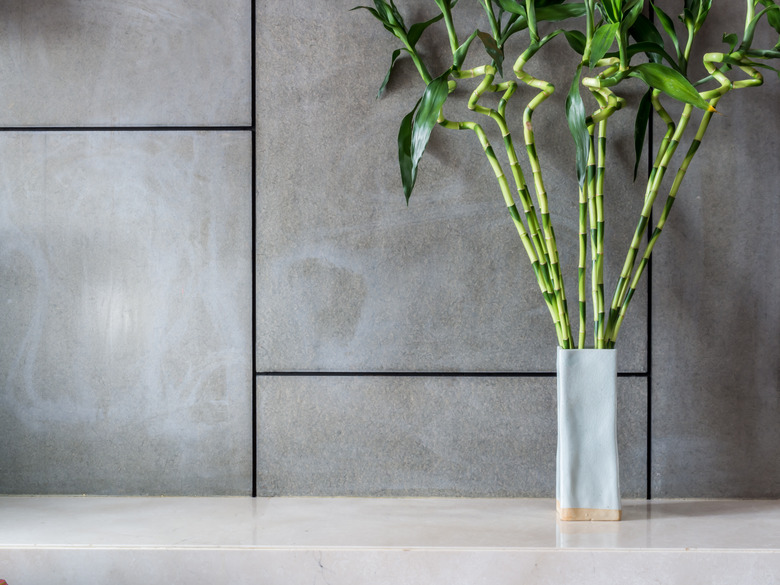Spiral Bamboo Plant
A spiral bamboo plant isn't bamboo at all. Spiral bamboo is a specially grown version of what is commonly called lucky bamboo (Dracaena sanderiana, USDA zones 9-12). This extremely easy-to-grow plant is often given as a gift for luck or for money. Chinese tradition and the practice of feng shui hold that different numbers of stalks direct good energy to various aspects of an individual's life. Although it's often grown hydroponically (in water), spiral bamboo also grows well in soil as an indoor plant.
Spiral Growing Process
Spiral Growing Process
This plant doesn't grow naturally in a spiral shape. Achieving the spiral shape is a time-consuming process. The plant is placed in a three-sided box, allowing only one side at a time to be exposed to the light. The plant naturally grows toward the light, and once a spiral is achieved, sometimes in as long as six months, the plant is turned and the box modified so another portion of the plant has access to light. This process continues until the desired twists are achieved.
An easier method is to use floral wire or bonsai wire, but this only works for tender, young growth, before the plant stem becomes rigid. Loosely wrap the wire around the length of a supple stem, and gently form the stem into a spiral shape. The wire will hold the stem in a spiral shape until the stem matures, at which point you can gently remove the wire. The stem will now hold its spiral shape.
Indoor Spiral Bamboo Plant Conditions
Indoor Spiral Bamboo Plant Conditions
Normal household conditions and temperatures will support a spiral bamboo plant. Ideally, the indoor temperature should be between 60 and 85 degrees Fahrenheit. Spiral bamboo likes humidity, so if there isn't adequate humidity in the house, be sure to mist the plant with water in a spray bottle every other day. Spiral bamboo doesn't respond well to rapid temperature changes, so avoid placing it next to a door or a heat register.
Growing in Water
Growing in Water
If you grow your spiral bamboo in water, be sure to keep the roots covered and to keep the water level constant. The plant is sensitive to the salts and chemicals in tap water, so to avoid fluoride damage to the leaves, use distilled or filtered water. If neither of these is an option, let tap water sit overnight so that the chlorine can evaporate before using the water on the spiral bamboo. Otherwise, the leaf margins may turn brown.
Mist the leaves every two to three days to provide the necessary humidity. Change the water immediately if the leaves begin to yellow. Brown-tipped leaves may be a sign of fluoride burn; filter the water before use.
Growing in Soil
Growing in Soil
Plants that are successful in water may eventually need to be repotted on soil. If a hydroponic plant begins to fail, try planting it on soil. Use a good quality, general potting mix and amend it with sand or perlite for adequate drainage.
Potted spiral bamboo doesn't like wet feet nor does it like soil that's too dry. Water when the soil feels dry up to an inch deep. Stick your index finger in the soil up to the knuckle to test it. Don't forget to mist it with water every two to three days.
Sunlight and Fertilizer
Sunlight and Fertilizer
Keep a spiral bamboo plant out of direct sunlight. Too much sunlight causes the leaves to burn. Too little light will stunt the plant's growth. Plants grown in water and soil require the same amount of sunlight.
Use a water-soluble fertilizer and apply it to the plant every two weeks. If the leaves begin to yellow, this may be a sign of over-fertilization. Follow the instructions on the packaging and withhold fertilizer for several weeks.
Benefits of Spiral Bamboo Plants
Benefits of Spiral Bamboo Plants
Spiral bamboo plants can help improve air quality by removing harmful toxins out of the air. Plants certainly are more decorative than an air purifier, so place as many as you want in your living space. It's said to remove formaldehyde, benzene, toluene, xylene and trichloroethylene from the atmosphere.
Spiral bamboo is also commonly used by practitioners of feng shui. Three stalks bring happiness, five bring health, six harmony, and eight, 18, 28, or 38 stalks are given for prosperity.
